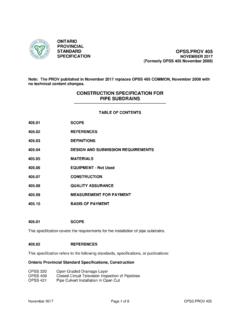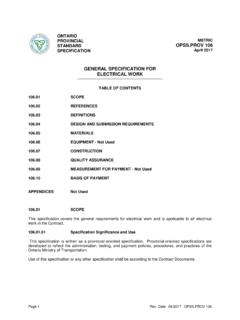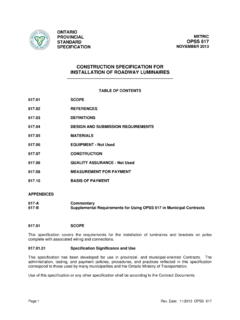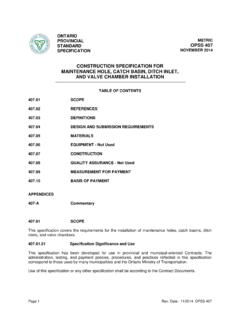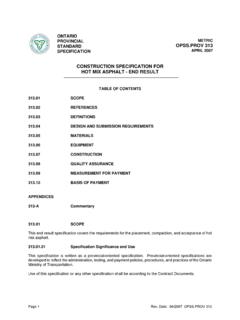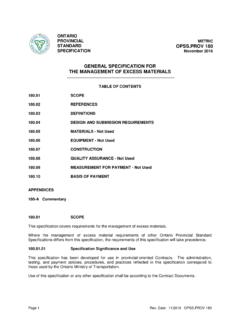Transcription of B517 - DEWATERING - OPSS 517 GENERAL
1 DETAIL estimating DEWATERING B517 - DEWATERING - OPSS 517 GENERAL DEWATERING is the work of removing water or lowering groundwater levels within the work area to facilitate construction. Temporary flow passage is the work of diverting water away from the work area to facilitate construction. Refer to Appendix A: MOECC DEWATERING Legislative Requirements and Application to Highway Construction projects for information related to water taking legislation. REFERENCES Provincial Engineering Memoranda MTO Gravity Pipe Design Guidelines MTO Highway Drainage Design Standards MTO Drainage Management Manual MTO IDF Curve Look Up Tool EPO Interpretive Bulletin Water Taking November 2016 TENDER ITEMS DEWATERING System (Normal, Non-PQP, Lump Sum) Temporary Flow Passage System (Normal, Non-PQP, Lump Sum) SPECIFICATIONS The requirements for DEWATERING system and temporary flow passage system are contained in OPSS 517.
2 SPECIAL PROVISIONS Refer to Chapter E of this manual to review the applicable standard special provisions. May 2017 Page 1 of 7 B517 DETAIL estimating DEWATERING STANDARD DRAWINGS There are no standard drawings applicable to this work. DESIGN The contractor is responsible for the design, installation, operation, maintenance and removal of any DEWATERING and temporary flow passage systems. Designers shall refer to the EPO Interpretive Bulletin Water Taking November 2016 for guidance on water taking activities on highway construction projects. A DEWATERING system is used for the removal of groundwater and includes stormwater resulting from rainfall events from within an excavation and may include use of a groundwater control system.
3 A temporary flow passage system is used for the passive (without pumping) or active (with pumping) diversion of surface water away from a working area including contingency measures to manage higher flows. The work of DEWATERING and/or temporary flow passage is normally included with the cost of the associated tender item. However, for some conditions, the work is paid separately through the DEWATERING system or temporary flow passage system item. The DEWATERING system or temporary flow passage system or both item(s) shall be used at locations where any of the following conditions apply: 1) Under normal summer construction season conditions, the volume of water to be pumped, diverted, or otherwise controlled by a DEWATERING system in order to carry out the work exceeds 400 m3/day.
4 2) The design storm return period for a temporary flow passage system, as determined according to MTO Highway Drainage Design Standard TW-1, exceeds 5 years. Note this standard only applies to passive systems. When the presence of fisheries significantly restricts the time available to carry out the work ( , in-water work timing window for fisheries), a longer return period may be specified to mitigate the potential schedule impacts due to inclement weather. 3) A DEWATERING or temporary flow passage system is required to rehabilitate a bridge or structural culvert. 4) The use of one or both of the items is recommended by the foundation engineer. May 2017 Page 2 of 7 B517 DETAIL estimating DEWATERING At locations where none of the above conditions apply, the DEWATERING system or temporary flow passage system item is not used, and the work required to control the water is part of the associated work item(s).
5 Only one or one of each item shall be used for each location where any of the above conditions apply. The item selection depends on the work required and/or the site conditions, and/or as recommended in the Foundation Investigation and Design Report or the Pavement Design Report. The items are typically used for culvert, sewer, and watermain work, but may also be used when structural rehabilitation work below water level is required or for other work requiring the control of water. These items are not used for the DEWATERING of excavations for the construction of structures. The DEWATERING Structure Excavations item is used for this work (see CDED B902). Typically, foundation investigations are carried out for the construction of new foundation components.
6 However, a foundation investigation may be appropriate solely for the purpose of providing soil and groundwater information for DEWATERING or temporary flow passage system bidding and design. Consult with a foundation or geotechnical engineer to determine if the site conditions warrant this investigation. Source of Information Sources of information include the Foundation Investigation and Design Report and hydrology and hydraulic analysis information for the design of the associated work. Information to be Provided to Bidders The following shall be provided for each location requiring the DEWATERING system or temporary flow passage system item: 1) The latitude and longitude co-ordinates for the IDF Curve as determined using the MTO IDF Curve Look up Tool for the contract.
7 On some contracts, there may have been more than one (1) IDF curve used and all locations shall be provided. 2) The minimum design storm return period, for temporary flow passage system item only. 3) Design flow rates corresponding to the 2, 5, 10 and 25-year return periods of the water body. The preconstruction survey distance, if required, that corresponds to an identified DEWATERING location. 4) When available, the Foundation Investigation Report and/or soils borehole logs. May 2017 Page 3 of 7 B517 DETAIL estimating DEWATERING Full engineering cross sections through the DEWATERING system and temporary flow passage system item locations and drainage channel cross sections obtained for the purpose of hydraulic analysis should be provided, when available.
8 COMPUTATION These are lump sum items, no quantity computation is required. DOCUMENTATION Contract Drawings Normally the contractor designs the temporary flow passage system alignment. However, when a temporary flow passage system must be constructed along a specific alignment, for example as a result of consultation with regulatory agencies, show the alignment on a drawing detail. When the alignment of the temporary flow passage system must be revised for different contract stages, show the alignment revision for each stage. Quantity Sheets A separate DEWATERING system or temporary flow passage system item shall be used for each location requiring the item. A separate quantity sheet column is required for each item. The location and position column of the quantity sheet shall show the station limits of the area requiring DEWATERING , and a description of the work requiring DEWATERING eg.
9 Sta. 12+455 12+490, C/L Culvert Replacement. A value of 100% is entered in the item quantity column. Tender Item List A separate DEWATERING system or temporary flow passage system item shall be used for each location requiring the item. Each separate location is located in a separate section of the tender item list. May 2017 Page 4 of 7 B517 DETAIL estimating DEWATERING Non-Standard Special Provisions A NSSP is required when flow rates through the work site requiring DEWATERING or temporary flow passage system are influenced by upstream control structures. Contact information, operating schedules, and other relevant information to be provided. NSSPs that red-flag site conditions or require system components (eg.)
10 Tremie plug for cofferdams) are included when recommended by the foundation engineer. Documentation Accuracy Record station entries to the nearest whole metre. May 2017 Page 5 of 7 B517 DETAIL estimating DEWATERING Appendix A MOECC DEWATERING Legislative Requirements and Application to Highway Construction Projects New Legislative Requirements: In 2016, the Ministry of Environment and Climate Change (MOECC) introduced new legislation on water taking for road construction purposes, and specifically applicable to this document, construction site DEWATERING . Water taking activities and sources were clarified and the legislative requirements redefined. Dependent on the water taking volume limits and sources of water, a Permit to Take Water (PTTW) or registration of the water taking activity in the Environmental Activity and Sector Registry (EASR) may or may not be required.

